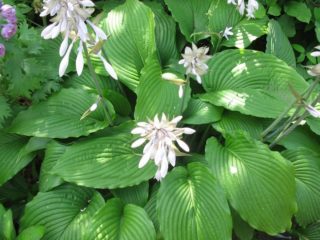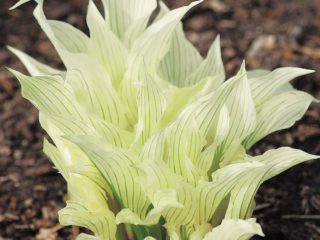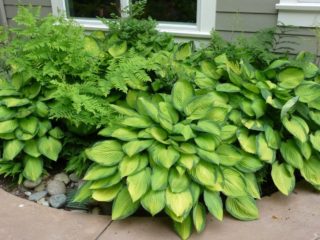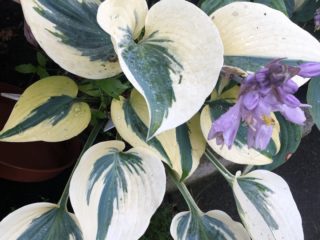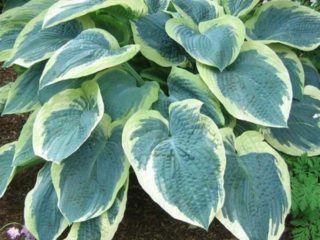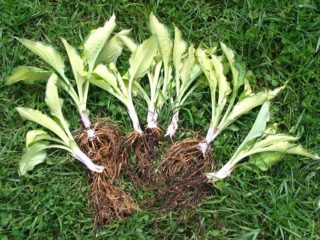Content
Hosta Elegance is one of the most famous hybrid varieties of this plant today. Its large, dense leaves are distinguished by a well-defined “waffle” surface relief and an unusual gray-blue color with a steel tint, which makes them very elegant and decorative. In addition, Hosta Elegans is undemanding in care, frost-resistant and grows well in almost any soil, preferring moderate humidity and partial shade. It is not surprising that this luxurious beauty has been loved by florists and landscape designers for over a hundred years. Hosta Elegans looks great both in single and group plantings, fits perfectly into any stylistic solutions, and its cut leaves harmoniously complement bouquets and compositions made from fresh flowers.
Description of Hosta Elegance
Hosta Siebold Elegans is a hybrid seedling obtained in 1905. Its authorship belongs to the German breeder Georg Arends. The Elegance variety was developed by crossing hostas Siebold and Fortune. The patent for it was registered in the AHS (American Hosta Society) in 1987.
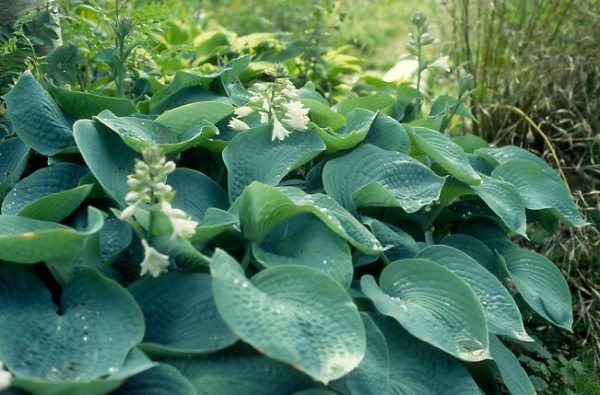
Elegance is a Siebold hosta variety beloved by designers and florists with large, wide leaves of gray-blue color.
Elegance is a large-sized hosta: the height of the bush is on average 0.6-0.9 m, and the width is 0.9-1.2 m. The wide oval leaves of this plant with a pointed outer end are shaped like a heart and reach 25- 36 cm long. They are very dense, have a wrinkled, “waffle” surface structure, on which large veins are clearly visible. The color of the leaf blades of Hosta Elegans is rich, gray-blue, turning into blue-green in bright light. The bluish waxy coating that thickly covers the leaves adds a characteristic metallic tint to their color.
The flowers of the plant appear in July-August. In shape they resemble elongated bells, collected in several dense brushes on short peduncles. The size of the Hosta Elegans flower is up to 6 cm, the color is white, often with a delicate lavender tint. There is no smell.
The fruit of Hosta Elegans is a dense, leathery capsule containing seeds. The latter can remain viable for up to 1 year.
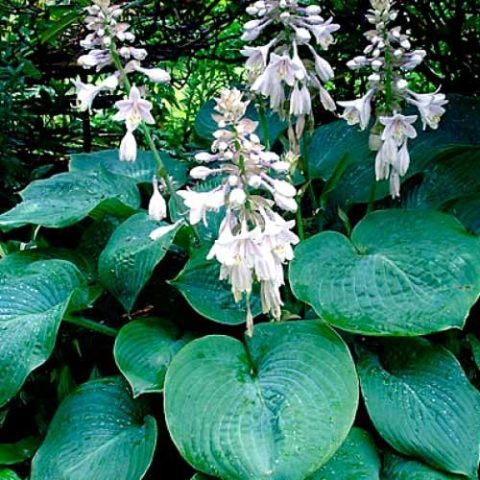
Hosta Elegans flowers can be white, with a delicate lavender tint.
Hosta Elegance does not tolerate excess sunlight, preferring to grow in shade or partial shade. It is moisture-loving and needs regular watering during hot periods. In favorable conditions, it grows quickly and easily, forming a lush, spreading bush.
The plant's winter hardiness is high: according to the USDA (United States Department of Agriculture) scale, Hosta Elegans can be grown in climate zone 4, in regions where the average annual air temperature in winter reaches 29-34 °C.In the Russian Federation, the Moscow region and most of the central regions of the country are considered such.
Application in landscape design
The ideas for using Hosta Elegance in the design of a site are inexhaustible. The most common options:
- creating a lower tier in multi-level flower beds, mixborders;
- landing on the shore of a reservoir or in a rock garden surrounded by stones;
- groups with flowering perennials in ridges and borders;
- planting ornamental shrubs and coniferous trees in the shade;
- solitary and group plantings on open lawns, lawns, terraces;
- compositions in natural style gardens.
Hosta Elegance retains its decorative appearance from May to September. Taking this into account, you should choose the right “neighbors” for it so that the planting always looks beautiful:
- Hosta sprouts begin to emerge from the ground in the spring, at the height of the flowering of apple trees, lilacs, primroses and irises.
- The wide leaves of this plant unfurl at the end of May. During this period, they perfectly camouflage faded bulbous flowers: crocuses, pushkinias, muscari.
- Hosta Elegans, planted in the lower tier of a mixed multi-level flowerbed, will become a wonderful cover for this part of the stems of tall flowering plants - paniculate phlox, daylilies.
- In summer, a spreading large hosta will create an excellent background for blooming peonies and roses.
- In the shady areas of the garden, she will be accompanied by astilbes, kupenas, brunners, ferns, lobelias, hellebores, marsh irises, and morning glory.
- Landscape compositions that combine Elegance and other hosta varieties in contrasting colors look beautiful and elegant.
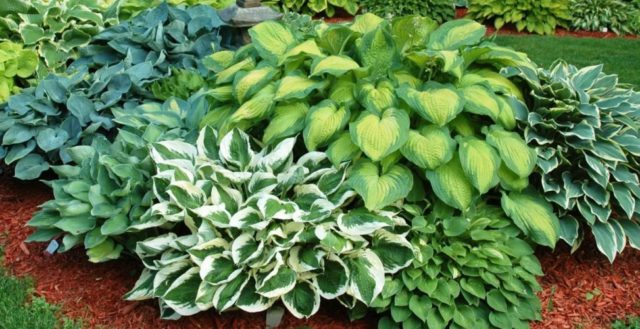
One of the options for using Elegance in design is to combine it with hostas of other species and varieties.
Reproduction methods
The most common hosta propagation methods:
- dividing the bush;
- cuttings;
- growing from seeds.
Most often, gardeners use the first method. Hosta Siebold Elegans is usually divided at the end of August. To do this, choose an adult bush at the age of 5-6 years. Before the procedure, the plant is watered abundantly, then carefully dug out of the ground along with its roots. Next, using a knife or shovel, the rhizome is divided into 2-3 parts, which are planted in separate holes.
In order to propagate Hosta Elegans from cuttings, you do not need to dig up the entire bush. At the stage of active growth (from May to early August), you should carefully separate the low shoot with the rhizome, the so-called “heel”. Half the leaves on the cutting need to be cut off, giving the host the opportunity to direct maximum energy to the development of roots. In the first few days after planting the shoot in a separate hole, it should be placed under a transparent “greenhouse” cover, sprayed daily and watered well.
Propagating Hosta Elegans by seeds is a very troublesome and labor-intensive method. In addition, seedlings do not always retain varietal characteristics. Sowing is done in February, in containers with a moist nutrient substrate. After the seedlings grow older, they are planted in separate containers for growing. Small plants develop slowly. They can be transplanted into open ground only after 3 years. The soil is first dug up with manure added and watered well.In this case, the decorative effect can appear only in the 4-5th year of the plant’s life.
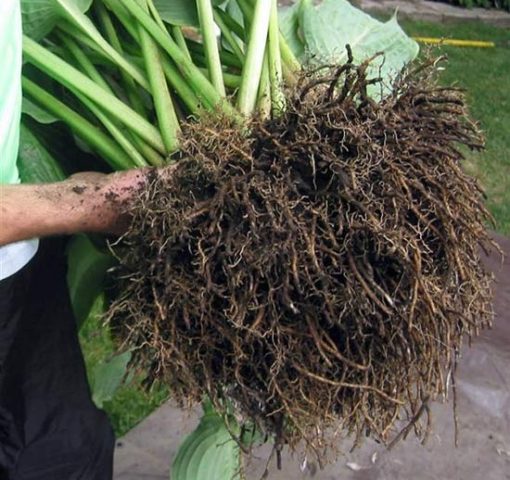
Dividing the bush is the most popular method of propagating hostas.
Landing algorithm
Hosta Elegans seedlings are usually planted in spring or early autumn.
If we are talking about dividing a bush, then it is carried out exclusively in the fall: the root system of Hosta Siebold begins to develop only after the leaves unfold. “Delenki” planted in the spring will not be able to take root.
The optimal place for growing Hosta Elegance should be in deep or open shade and protected from drafts and strong winds. The soil needs to be light, nutritious, water- and breathable (ideally slightly acidic loam).
It is recommended to buy Hosta Elegance seedlings in winter, in a “dormant” state. They should have strong, healthy roots and a clearly visible, developed leaf bud. “Sleeping” seedlings are recommended to be stored in a dark, cool place (basement, refrigerator, glassed-in loggia). Immediately before planting in the ground, the rhizome should be inspected, if necessary, cut off rotten areas, disinfecting the sections with brilliant green, and treat with a weak solution of potassium permanganate.
Hostas Elegance are planted as follows:
- dig a hole about 40 cm deep in the area, the length and width of which will correspond to the diameter of an adult bush;
- drainage is poured to the bottom;
- the soil for planting, selected from the pit, is filled with humus, compost, and rotted manure;
- a mound is formed in the hole, on which the hosta elegans seedling is placed vertically, making sure that the root collar is at ground level;
- carefully straighten the roots of the plant;
- pour soil into the hole and press it lightly so that there are no “air pockets” left below;
- Water the hosta generously;
- mulch the ground with sawdust, crushed tree bark, peat or dry humus.
Growing rules
Hosta elegans is an undemanding plant. Caring for it is not difficult, but must be done correctly.
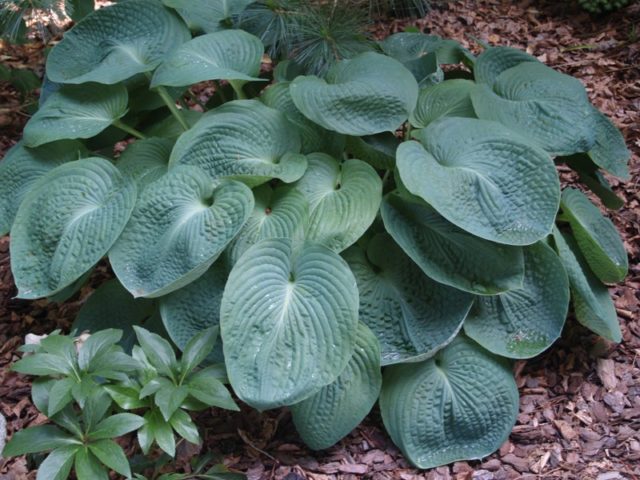
Hosta Elegance exhibits its decorative properties best when planted in shade or partial shade.
Basic Rules:
- Hosta Elegans loves moist soil, but without stagnant water. It is necessary to water it in a timely manner, making sure that the soil at the roots does not dry out - approximately once every 3-4 days. It is best to do this in the morning or evening. Excessive moisture at the roots can cause them to rot.
- Feed Hosta Elegance three times during the season, alternating mineral fertilizers with organic ones. It is recommended to follow this regimen: first in the spring, when the period of its active growth begins, then during flowering and after it ends.
- Loosening the soil under Hosta Elegans should be done with caution. The roots of the plant are very close to the surface of the earth, so they are easily injured. It is best not to loosen the soil, but to mulch it, especially since the hosta leaves practically no room for weeds to grow.
Preparing for winter
Although Hosta Elegans has good frost resistance, it should also be prepared in a certain way for the onset of winter.The set of necessary measures depends on the climate in which it grows. The more severe the winter is expected, the more responsible you need to be in organizing special care during this period.
Preparing Hosta Elegance for winter includes the following activities:
- In the fall, after the plant has flowered, it is necessary to prune it. Some gardeners remove exclusively flower stalks, but at the same time leave dying foliage on the bush so that in winter it additionally covers the roots of the plant. Another part of gardeners in the autumn necessarily trims off all yellowed leaves from the hosta. They motivate their actions by the fact that slugs and snails usually spend the winter in old foliage, which, waking up in the spring, will begin to actively eat young greenery. Specific dates for when Hosta Elegance should be pruned are usually not given, but it is recommended to do it two to three weeks before the expected cold weather.
- Elegance is not fertilized in the autumn. Phosphorus-potassium compounds added to the soil in mid-July and early August help the plant recover after flowering and prepare for the cold.
- Before the onset of winter, the soil under Hosta Elegans is mulched with a layer of humus or peat approximately 15-17 cm thick. If severe frosts are expected, you can additionally cover the bush with coniferous spruce branches or “breathing” agrofibre.
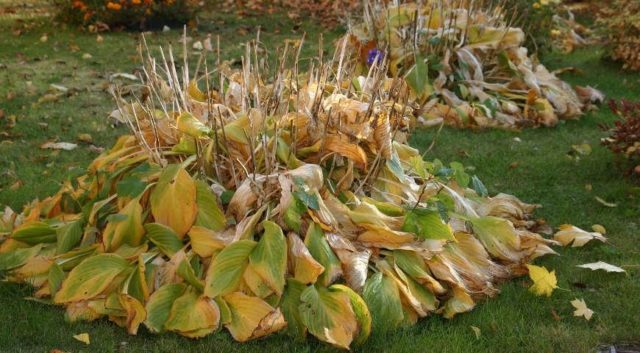
Some gardeners recommend cutting off yellowed and wilted hosta foliage for the winter, while others advise leaving it as a winter shelter for the roots.
Diseases and pests
Hosta elegans is considered resistant to most diseases and pests. However, some of them can still significantly harm the health of the plant, so you should know how to recognize the symptoms and how you can help the flower.
A dangerous, but fortunately uncommon disease is root collar rot. Hosta Elegans may be affected by it for the following reasons:
- grows in a too thick flower garden;
- the soil on the site is too dense, does not allow water to pass through well, and remains damp for a long time;
- when planting, the bush was too deep into the ground;
- applied too much fertilizer.
A sign of the disease is discolored and rapidly dying leaves. Sometimes they dry out, other times they soften and become sticky.
To save Hosta Elegans, you should dig it up, cut off the rotten parts of the part with a sterile knife, treat the rhizome with a fungicide and transplant the bush to a new place.
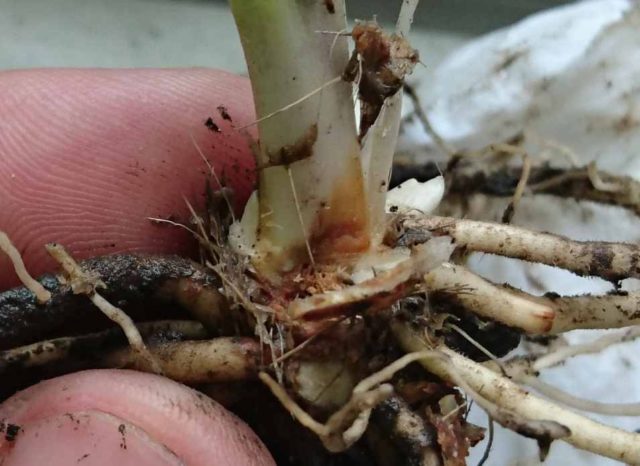
Root collar rot can destroy the hosta if action is not taken promptly.
Occasionally, a plant can be affected by phyllosticosis, a fungal disease that manifests itself in the form of brown, enlarging spots on peduncles and foliage. If the host disease is severe, Elegance may die. To save the bush, the affected organs must be pruned and burned, and the host must be treated with Vectra or Abiga-Peak (twice with an interval of 10 days). Additionally, you can spray the leaves with an aqueous solution of colloidal sulfur (100 g per 1 bucket).
Slugs and snails usually cause significant damage to hostas. They eat holes in the young leaves of the plant and leave traces of silvery mucus on their surface. The drugs “Thunderstorm” and “Slug Eater” are effective against these pests. You can also install beer traps under plants, mulch the soil with pine needles, broken eggshells, wood ash, and collect parasites by hand. But it is worth noting that thin-leaved varieties most often suffer from these pests. Hosta Elegans with its dense, durable greenery is usually too much for them.
Conclusion
Hosta Elegans is a constant classic among the large, large-leaved representatives of this genus. The variety, bred more than a hundred years ago, is still very popular in ornamental gardening. Among the undoubted advantages of Hosta Elegance are its unpretentiousness and frost resistance, as well as its low susceptibility to diseases and pest attacks. By planting the bush in moist, fertile soil in a corner of the garden protected from the sun and providing simple care for it, you can admire the beautiful “queen of shadow” from late spring to early autumn. Luxurious dense “fountains” of gray-blue leaves with a bluish waxy tint will adequately decorate any composition and help realize the most intricate design idea.
Reviews
